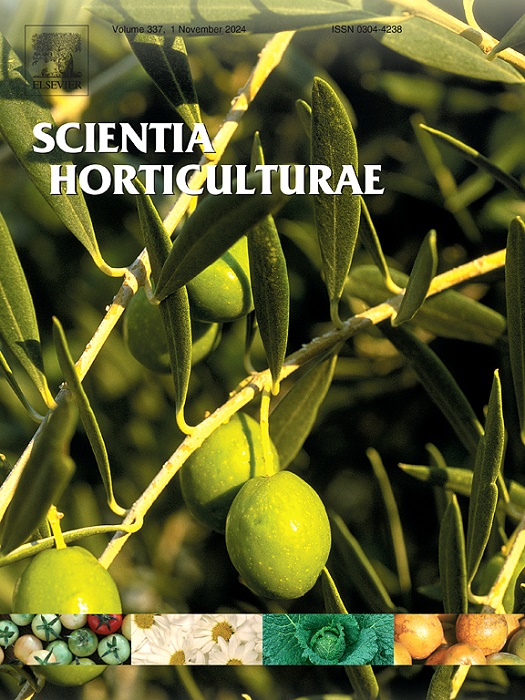Identification of morphological characteristics and light environment strategies to mitigate intumescence in water spinach cultivated in a plant factory with artificial lighting
IF 4.2
2区 农林科学
Q1 HORTICULTURE
引用次数: 0
Abstract
Water spinach (Ipomoea aquatica Forrsk.) is a productive aquatic plant extensively cultivated in tropical and subtropical areas; nonetheless, it is susceptible to intumescence, a physiological condition that reduces growth and commercial value, particularly in plant factories employing artificial lighting. This study investigated the characteristics of intumescence and explored light strategies to mitigate its incidence. Seedlings were grown under white LEDs with a light intensity of 100 μmol m−2 s−1 for seven days during seedling production. Air temperature and relative humidity were maintained at 24/20 °C and 65/85 % (photo-/dark periods), respectively, and the CO₂ concentration was maintained at 800 μmol mol−1. Seedlings were transplanted at planting densities of 105.8, 211.6, and 846.6 plants/m2 and exposed to photosynthetic photon flux density (PPFD) levels of 100, 200, and 300 μmol m−2 s−1 for 21 days. Another experiment maintained the same daily light integral (DLI) of 11.52 mol m−2 d−1 across all treatments, which consisted of three combinations of PPFD (320, 200, and 160 μmol m−2 s−1) and photoperiod (10, 16, and 20 h d−1). The third experiment used high-density planting (846.6 plants/m2) under a PPFD of 300 μmol m−2 s−1 with supplementary UV-B radiation (0.0, 1.0, 1.5, and 2.0 W m−2) for four hours daily. In water spinach, intumescence symptoms under these conditions involved hypertrophy of spongy parenchyma cells in leaves and hyperplasia of collenchyma cells in stems, accompanied by cuticular abnormalities that are likely to impair photosynthesis and reduce the commercial value of the crop. Higher PPFD increased biomass at lower densities, whereas mutual shading at denser planting reduced the light availability. Longer photoperiods with lower light intensities reduced intumescence severity while maintaining yield at the same DLI. UV-B supplementation at 1.0 W m−2 effectively mitigated intumescence without reducing growth, while higher UV-B intensities negatively impacted growth. Cultivating water spinach at 300 μmol m−2 s−1 PPFD with high planting density and 1.0 W m−2 UV-B radiation minimizes intumescence while ensuring high yield and quality.
植物工厂人工照明栽培的水菠菜形态特征及光环境策略的研究
水菠菜(Ipomoea aquatica Forrsk.)是一种多产的水生植物,广泛种植于热带和亚热带地区;然而,它很容易膨胀,这是一种降低生长和商业价值的生理状况,特别是在使用人工照明的植物工厂。本研究探讨了肿胀的特点,并探讨了减轻其发生率的光策略。幼苗在100 μmol m−2 s−1光强的白光led下生长7 d。空气温度和相对湿度分别保持在24/20℃和65/ 85%(光照/暗期),CO₂浓度保持在800 μmol mol−1。幼苗在105.8、211.6和846.6株/m2的种植密度下移栽,在100、200和300 μmol m−2 s−1的光合光子通量密度(PPFD)水平下移栽21 d。在另一个试验中,在PPFD(320、200和160 μmol m−2 s−1)和光周期(10、16和20 h d−1)的三种组合下,所有处理的日光积分(DLI)均保持在11.52 mol m−2 d−1。第三个试验采用高密度种植(846.6株/m2), PPFD为300 μmol m−2 s−1,外加UV-B辐射(0.0、1.0、1.5和2.0 W m−2),每天4 h。在这些条件下,水菠菜的膨胀症状包括叶片中海绵薄壁细胞的肥大和茎中厚壁细胞的增生,并伴有角质层异常,这可能会损害光合作用,降低作物的商业价值。较高的PPFD在较低密度下增加了生物量,而较密种植的相互遮荫则降低了光利用率。较长的光周期和较低的光强降低了膨胀的严重程度,同时保持了相同DLI的产量。添加1.0 W m−2的UV-B可以有效地缓解肿胀而不降低生长,而更高的UV-B强度会对生长产生负面影响。在300 μmol m−2 s−1 PPFD、高种植密度和1.0 W m−2 UV-B辐射条件下培养菠菜,在保证高产优质的同时最大限度地减少膨胀。
本文章由计算机程序翻译,如有差异,请以英文原文为准。
求助全文
约1分钟内获得全文
求助全文
来源期刊

Scientia Horticulturae
农林科学-园艺
CiteScore
8.60
自引率
4.70%
发文量
796
审稿时长
47 days
期刊介绍:
Scientia Horticulturae is an international journal publishing research related to horticultural crops. Articles in the journal deal with open or protected production of vegetables, fruits, edible fungi and ornamentals under temperate, subtropical and tropical conditions. Papers in related areas (biochemistry, micropropagation, soil science, plant breeding, plant physiology, phytopathology, etc.) are considered, if they contain information of direct significance to horticulture. Papers on the technical aspects of horticulture (engineering, crop processing, storage, transport etc.) are accepted for publication only if they relate directly to the living product. In the case of plantation crops, those yielding a product that may be used fresh (e.g. tropical vegetables, citrus, bananas, and other fruits) will be considered, while those papers describing the processing of the product (e.g. rubber, tobacco, and quinine) will not. The scope of the journal includes all horticultural crops but does not include speciality crops such as, medicinal crops or forestry crops, such as bamboo. Basic molecular studies without any direct application in horticulture will not be considered for this journal.
 求助内容:
求助内容: 应助结果提醒方式:
应助结果提醒方式:


